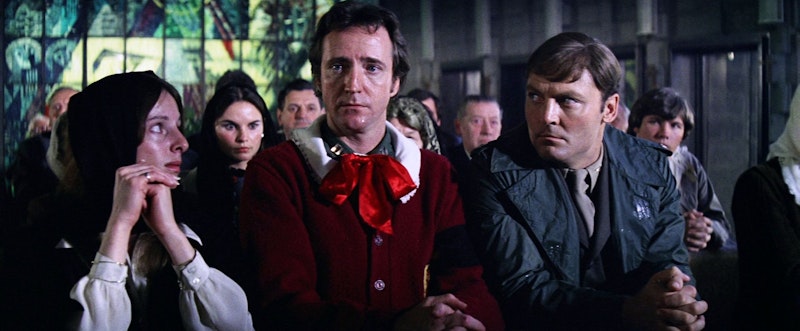The 12th film in Criterion Channel’s Frame of Mind collection, a selection of movies about psychiatry, is 1980's The Ninth Configuration. Written and directed by William Peter Blatty, based on his own novel, it’s not a story about psychiatry, though it’s set in a particularly eccentric mental institution. It’s instead about sacrifice, morality, altruism and the relation of man and God. But to fully understand what’s happening in this film, it’s necessary to understand its links to the wider William Peter Blatty Cinematic Universe.
Start with the plot: in the early-1970s, as the American presence in Vietnam staggers to its end, Colonel Kane (Stacy Keach) arrives at a castle in the Pacific Northwest to take command of an asylum full of psychotic servicemen. The authorities suspect they’re faking madness to get out of their jobs; part of Kane’s task is to figure out if that’s true. Kane lets the inmates pursue the projects they’re obsessed with, whether training their atoms to pass through solid matter or staging the works of Shakespeare with dogs for actors.
Kane’s drawn to one particular patient, though, an astronaut named Billy Cutshaw (Scott Wilson) who cracked up on the launch pad or wants people to think he did. Kane and Cutshaw embark on a series of dialogues about morality and sacrifice: Cutshaw believes the cosmos is meaningless, and Kane talks about the mathematical unlikeliness of human life and how improbable it is that hundreds of millions of protein molecules of “the ninth configuration” should randomly appear on Earth (without ever explaining what the ninth configuration of protein molecules means).
There’s a surprising revelation about Kane late in the film, after which he sacrifices himself for Cutshaw. That sacrifice is somewhat undermined by an act of violence, but a supernatural moment at the end of the film implies a redemption for him and restores Cutshaw’s faith in God.
It’s a well-written movie, the screenplay thoughtful and filled with a surreal comedy that’s played perfectly straight. Keach is perhaps too muted as Kane, but then he’s playing against a castle full of zanies. The castle itself has a fascinating atmosphere, a horror-movie background that somehow is less horrific than bizarre.
The twist is a little obvious, mostly because it’s been done several times since. The fight scene near the end makes dramatic sense, but is poorly staged, and the redemptive final small miracle feels like too large a step into the fantastic. Still, the movie’s fascination with what underlies the apparent randomness of life is explored well. There’s ambition here, and if the movie doesn’t entirely work it’s still an intriguing artifact.
That ambition becomes clearer in light of the movie’s connection to The Exorcist. The background: in 1966 Blatty published his novel Twinkle, Twinkle, "Killer" Kane!, followed it with The Exorcist in 1971, then rewrote Kane as The Ninth Configuration and published the revised book in 1978. By that time The Exorcist had been filmed, in 1973. Blatty then raised money himself to adapt The Ninth Configuration, and shot it in Hungary with complete creative control.
This is all relevant because Blatty included a scene in The Exorcist in which the little girl possessed by a demon tells an astronaut, “You’re gonna die up there.” Blatty’s said he intended the astronaut in that scene to be Cutshaw, establishing a reason for Cutshaw’s madness—as we find out near the end of Ninth Configuration, he feared going up into space, feared dying alone in the absence of God. Blatty intended that fear to be sparked by his brief confrontation with a demon.
Kane’s sacrifice at the end of The Ninth Configuration inspires Cutshaw to go up into space after all, not because he thinks he won’t die but because he’s convinced of altruism and of God: so Cutshaw is inspired by Kane to sacrifice himself in turn. Kane’s sacrifice is presumably undermined by his indulgence in an act of violence, but if he can’t attain Christ-like pacifism, Cutshaw has a chance to redeem that failure. The movie becomes a neat parable about goodness sparking belief in the divine—or would, except that after an ostensibly realist if satirical film, the final miracle’s too heavy-handed.
But if we understand this is the world of The Exorcist, we understand this is a world in which demons are real and can assume miracles are real as well. Which means the ending makes more narrative sense viewed in context with The Exorcist. In fact the connection to the earlier movie calls a few other things into question; a flashback to Vietnam, for example, where a decapitated head keeps talking—is that hallucination, or a supernatural sign? (I note that there’s also a minor continuity issue with the two movies, as The Ninth Configuration is stated to take place near the end of the Vietnam War while the Blatty-directed Exorcist III establishes that The Exorcist took place in 1975. How much this matters may be left to the discretion of the individual viewer.)
As you might expect from the foregoing, psychiatry in The Ninth Configuration is not seriously explored as a science or a technique. The movie’s a meditation on the insanity of the world: “I don’t think evil grows out of madness,” Kane muses at one point. “I think madness grows out of evil.” Madness comes from a confrontation with the absurdity of life. The story presents a kind of Catholic existentialism, in which the world’s absurdity is a test of faith, and shamming madness, unbelief, is a dereliction of duty.
In which case psychiatry’s pointless. Every mind that has worked to develop psychiatric theory was itself shaped by the madness of the world, which derives from original sin. How can you cure the madness built into the entire world? Not, the film implies, with science and theories of the mind. With faith, perhaps, or with some perfect sacrifice. It’s not a therapy I believe in, but the cinematic expression of the idea is effective.

